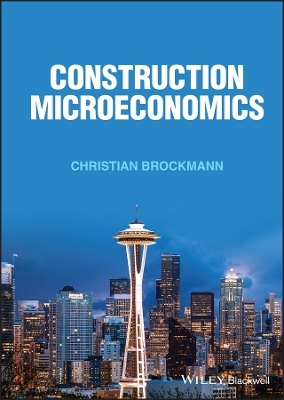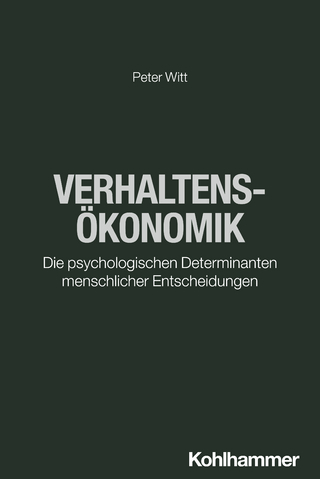
Construction Microeconomics
Wiley-Blackwell (Verlag)
978-1-119-82878-5 (ISBN)
Construction Microeconomics provides comprehensive coverage of microeconomics applied to the construction industry, focusing on construction clients, who initiate construction projects, and on contractors who transform the ideas and plans of clients into infrastructure and buildings. With the help of microeconomic theory, it tries to answer questions about decision-making by clients, contractors, and governments with respect to projects in the built environment. It includes discussions of alternative theories to mainstream microeconomics, such as new institutional economics, behavioral economics, and the capability approach. Applications from the construction sector including land supply, sustainability, industrialization, and lean construction are provided to ground the theory in practical construction.
In Construction Microeconomics, readers will learn:
How microeconomic theory relies heavily on assumptions for modeling and the nuances of adjusting those assumptions
How heterogenous contract goods affect supply and demand, markets, information, technology, and accordingly, the theories of contractors and owners
How interaction influences the production process and how land as a production factor changes the production function
How ex-ante costs determine the cost theory of the contractor and why contracting is more akin to the service sector than the goods sector
Advanced undergraduate and masters students, lecturers and academics in construction and related disciplines, and professionals in the construction industry looking for expert analysis into a unique facet of the field will find Construction Microeconomics to be a valuable, complete, and authoritative reference on the subject.
Christian Brockmann is Professor (Lecturer) of Construction Engineering at the University of Utah, USA. He holds a PhD in construction management from ETH Zurich (Switzerland) and a PhD in Economics from TU Freiberg (Germany). With over 20 years’ experience in the management of major infrastructure projects as a contractor and consultant, Christian was Project Director for the BangNa Expressway in Thailand and the Port Said Tunnels in Egypt, (both $2b+ projects), and was part of the Owner’s Project Management Team for the Qatar Integrated Railway Project (a $40b+ project).
Foreword by Gerard de Valence xix
Preface xxi
References xxvi
1 Introduction 1
1.1 Navigating the Maze of Economic Literature 2
1.1.1 Economics 2
1.1.2 Microeconomics 3
1.1.3 Macroeconomics 4
1.1.4 Construction Economics 4
1.2 Tools and Presentations 5
1.2.1 Definitions 5
1.2.2 Economic Scholars 6
1.2.3 Assumptions 6
1.2.4 Case Studies 6
1.2.5 Observations 7
1.2.6 Summaries 7
1.3 Methodological Approach 8
1.3.1 Laws and Regularities 8
1.3.2 Focus and Goals 11
1.3.3 Descriptive and Normative Economics 12
1.4 Theoretical Background 13
1.4.1 Industrial Economics 13
1.4.2 New Institutional Economics 14
1.4.3 Game Theory 15
1.4.4 Auction Theory 16
1.4.5 Behavioral Economics 16
1.4.6 Economics of Information 17
1.4.7 Law and Economics 17
1.5 What You Can and Cannot Expect 17
1.6 Audience 19
1.6.1 Students 19
1.6.2 Lecturers 19 1.6.3 Academics 19
1.6.4 Contractors 19
1.6.5 Owners 20
1.6.6 Policymakers 20
1.7 Structure of the Text 20
1.7.1 Basic Economic Principles 20
1.7.2 Consumers in Perfectly Competitive Markets 21
1.7.3 Producers in Perfectly Competitive Markets 21
1.7.4 Interaction in Perfectly Competitive Markets 21
1.7.5 Imperfect Markets 22
1.7.6 Factor Markets 22
1.7.7 Information, Risk, and Uncertainty 22
1.7.8 Game Theory and Auctions 23
1.7.9 Construction Sector 23
1.7.10 Theory of the Owner 23
1.7.11 Theory of the Contractor 24
1.7.12 Construction Goods 24
1.7.13 Construction Markets 24
1.7.14 Contracting 25
1.7.15 Market Imperfections 25
1.7.16 Government 25
1.7.17 Public Construction Goods 26
1.7.18 Conclusion 26
1.7.19 Synopsis 26
References 27
Part I Microeconomics 31
2 Basic Economic Principles 33
2.1 Consensual Ideas 35
2.2 Scarcity and Choice 36
2.3 Decision-Making 39
2.3.1 Opportunity Costs 39
2.3.2 Incentives 40
2.3.3 Marginal Decisions 41
2.4 Markets 41
2.5 Trade and Comparative Advantage 44
2.6 Government 47
References 48
3 Consumers in Perfectly Competitive Markets 51
3.1 Perfectly Competitive Markets 53
3.2 Consumer Behavior 55
3.2.1 Budget Constraint 55
3.2.2 Preferences and Utility Functions 56
3.2.3 Utility Maximization 60
3.3 Demand Curve 62
3.4 Further Reading 64
References 65
4 Producers in Perfectly Competitive Markets 67
4.1 Producer Behavior 68
4.2 Production Theory 70
4.2.1 Technology 71
4.2.2 Production Functions 75
4.2.2.1 Classical Production Function 77
4.2.2.2 Neoclassical Production Function 79
4.2.2.3 Limitational Production Function 82
4.2.2.4 Technological Change (Innovation) and Learning 83
4.3 Cost Theory 85
4.3.1 Cost Curves for Classical Production Functions 86
4.3.2 Cost Curves for Neoclassical Production Functions 88
4.3.3 Cost Curves for Limitational Production Functions 89
4.3.4 Simplified Cost Function with Constantly Increasing Variable Costs 89
4.3.5 Long-Run Cost Curves 91
4.4 Supply Curve 92
4.4.1 Short-Run Supply Curve of a Firm 92
4.4.2 Long-Run Supply Curve of a Firm 94
4.4.3 Market Supply Curve 94
References 95
5 Interaction in Perfectly Competitive Markets 97
5.1 Equilibrium Price and Quantity 99
5.2 Comparative Statics 101
5.3 Elasticities of Demand and Supply 102
5.4 Consumer and Producer Surplus 106
5.5 Time-Dependent Supply Curves and Market Outcomes 107
5.5.1 Very-Short-Run Supply Curve 108
5.5.2 Short-Run Supply Curve 108
5.5.3 Long-Run Supply Curve 109
5.6 Welfare 110
5.7 Efficiency and Equity 112
References 113
6 Imperfect Markets 115
6.1 Monopoly 117
6.1.1 Normal Monopolies 118
6.1.2 Natural Monopolies 120
6.2 Monopolistic Competition 121
6.3 Monopsony 124
6.4 Oligopoly 125
References 126
7 Factor Markets 129
7.1 Factor Supply of Households 131
7.1.1 Labor Supply 131
7.1.2 Capital Supply 133
7.2 Factor Demand of Firms 135
7.3 Demand and Supply on Factor Markets 137
References 137
8 Uncertainty, Risk, and Information 139
8.1 Uncertainty and Risk 140
8.1.1 Risk Attitudes 141
8.1.2 Risk Strategies 142
8.1.3 Transaction Cost Theory 144
8.2 Information 146
8.2.1 Satisficing Model of Decision-Making 146
8.2.2 Asymmetric Information 149
8.2.2.1 Principal–Agent Theory 149
8.2.2.2 Market Breakdown Due to Asymmetric Information 149
8.2.2.3 Hidden Characteristics and Adverse Selection 150
8.2.2.4 Hidden Intentions and Holdup 151
8.2.2.5 Hidden Action and Moral Hazard 152
8.2.3 Property Rights Theory 153
References 153
9 Game Theory and Auctions 155
9.1 Game Theory 156
9.1.1 Basics of Game Theory 157
9.1.2 Static Games with Complete Information 159
9.1.3 Dynamic Games with Complete Information 160
9.2 Auctions 161
9.2.1 Basics of Auctions 161
9.2.2 English and Vickrey Auctions 163
9.2.3 Dutch Auctions and Sealed-Bid Auctions 164
9.2.4 Competitive Bidding 164
References 167
Part II Applied Construction Microeconomics 169
10 Construction Sector 171
10.1 Definition 172
10.2 Economic Contribution 174
10.2.1 Value-Added Concept 174
10.2.2 Investment Concept 176
10.2.3 Multiplier Concept 177
10.3 Actors in the Construction Sector 179
10.3.1 Market Demand 181
10.3.2 Market Supply 183
10.4 Summary of the Construction Sector 185
References 186
11 Theory of the Owner 189
11.1 The Owner as an Entity 190
11.1.1 Terminology 190
11.1.2 Images and Prejudices 191
11.1.3 Organization 192
11.2 Tasks of the Owner 194
11.3 Behavior of the Owner 195
11.3.1 Consumers Buying Construction Goods 195
11.3.2 Producers Buying Construction Goods 196
11.4 Information of the Owner 197
11.5 Developing a Contract 198
11.6 Procurement of a Contractor 199
11.7 Supervision of the Construction Process 202
11.8 Summary 203
References 203
12 Theory of the Contractor 205
12.1 The Contractor as an Entity 205
12.1.1 Cooperation 206
12.1.2 Organization 207
12.2 Tasks of the Contractor 208
12.3 Behavior of the Contractor 209
12.3.1 Strategy 211
12.3.2 Legal Organization 212
12.3.3 Growth of the Firm 214
12.4 Information of the Contractor 215
12.5 Bidding 216
12.6 Contractor Pricing 217
12.7 Production 220
12.7.1 General Characteristics 220
12.7.2 Production Determinants 222
12.7.2.1 Production Line, Work Shop, Site Construction, Parallel, or Variable Production 222
12.7.2.2 Automatization 224
12.7.2.3 Mass or Single-Item Production 225
12.7.2.4 Continuous and Discontinuous Production 225
12.7.2.5 Summary of Production Types 226
12.7.3 Production Functions and Cost Curves 228
12.7.4 Production Decisions 233
12.8 Summary 234
References 234
13 Construction Goods 237
13.1 Goods and Services 237
13.1.1 Heterogeneity 238
13.1.2 Construction Goods as Transitional Performance Bundles 240
13.1.3 Construction Goods as Contract Goods 242
13.1.4 Construction Goods as Investment 244
13.1.5 Construction Goods as Services 244
13.1.6 Summary of the Characteristics of Construction Goods 246
13.2 Typology of Construction Goods 247
13.2.1 Approach to Developing a Typology 248
13.2.2 Conceptualization 248
13.2.2.1 Choice of Dimensions 249
13.2.2.2 Typical Cases 250
13.2.2.3 Typology 250
13.2.3 Applications 253
13.2.3.1 Market Entry 253
13.2.3.2 Optimum Firm Size 253
13.2.3.3 Strategic Planning 255
13.3 Summary 256
References 256
14 Construction Markets 259
14.1 Characteristics of Markets 259
14.2 Particularities of Construction Markets 261
14.2.1 Goods 261
14.2.2 Owners 262
14.2.3 Markets 262
14.2.4 Summary 263
14.3 Analysis of Construction Markets 263
14.3.1 Heterogeneity 265
14.3.1.1 Observation 266
14.3.1.2 Theory 266
14.3.1.3 Organization 266
14.3.1.4 Structure 266
14.3.1.5 Specialization 267
14.3.1.6 Law 267
14.4 Owners 268
14.5 Contractors 268
14.5.1 Supply 268
14.5.2 Information 269
14.6 Geography of Construction Markets 270
14.6.1 Regional Markets 271
14.6.2 National Markets 274
14.6.3 International Markets 279
14.6.4 Multinational Markets 280
14.6.5 Global Players and Global Markets 283
14.7 Entry and Exit Barriers 285
14.7.1 Effects of the Business Cycle 286
14.7.2 Number of Exits and Entries 290
14.8 Summary 292
References 293
15 Contracting 297
15.1 Construction Goods 298
15.2 Construction Markets 300
15.3 Owner’s Demand 301
15.4 Contractor’s Supply 302
15.5 Construction Contracts 303
15.6 Contracting Market Design 305
15.7 Pricing of Construction Contracts 307
15.7.1 Marginal Cost Decisions Versus Markup Pricing 308
15.7.2 Auctioning 310
15.7.2.1 Construction Goods and Auctions 310
15.7.2.2 Auction Designs 312
15.7.3 Sealed-Bid Auctions 315
15.7.3.1 Pricing in Sealed-Bid Auctions 316
15.7.3.2 Pricing bias 316
15.7.3.3 Information Bias 317
15.7.3.4 Uncertainty Bias 318
15.7.3.5 Technology Advance 319
15.8 Supply and Demand in Construction 319
15.9 The Owner as Monopsonist 320
15.10 Bargaining for the Contract Price 322
15.11 Change Orders and Claims 325
15.12 Summary 326
References 327
16 Market Imperfections 329
16.1 Imperfect Information 329
16.2 Externalities 331
16.3 Collusion and Corruption 334
16.3.1 Collusion 334
16.3.1.1 Naturally Caused Collusion 336
16.3.1.2 Artificially Caused Collusion 337
16.3.2 Corruption 338
16.4 Mechanics or Ethics of Collusion 340
16.5 Conclusion 341
References 342
17 Government 343
17.1 Government as Actor on Markets 344
17.2 Taxes and Subsidies 346
17.3 Regulations 348
17.4 Interest Rates 350
17.5 Inflation 353 References 354
18 Public Goods 355
18.1 Characteristics of Private Goods 356
18.1.1 Rivalry 357
18.1.2 Excludability 358
18.2 Theory of Public Goods 359
18.2.1 Demand of a Public Good Based on Utility 360
18.2.2 Demand for a Public Good Based on Willingness to Pay 361
18.3 Free Riding 362
18.4 Cost–Benefit Analysis 363
18.5 Construction Goods as Public Goods 363
18.6 Strategic Misrepresentation and Optimism Bias 364
References 365
19 Conclusion 367
19.1 Methodical Context 367
19.2 Owners 369
19.3 Contractors 370
19.4 Construction Goods 371
19.5 Construction Markets 371
19.6 Contracting 373
References 374
Index 375
| Erscheinungsdatum | 27.01.2023 |
|---|---|
| Verlagsort | Hoboken |
| Sprache | englisch |
| Maße | 170 x 244 mm |
| Gewicht | 851 g |
| Themenwelt | Technik ► Bauwesen |
| Wirtschaft ► Volkswirtschaftslehre ► Mikroökonomie | |
| ISBN-10 | 1-119-82878-3 / 1119828783 |
| ISBN-13 | 978-1-119-82878-5 / 9781119828785 |
| Zustand | Neuware |
| Informationen gemäß Produktsicherheitsverordnung (GPSR) | |
| Haben Sie eine Frage zum Produkt? |
aus dem Bereich


